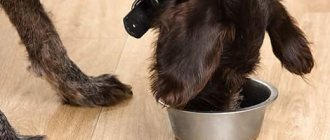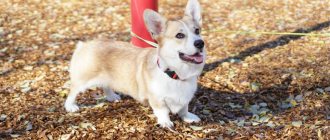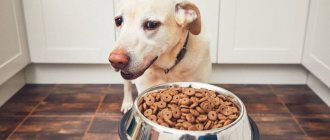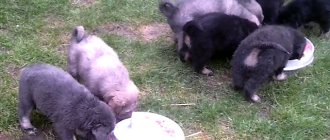How much meat does a dog need and does it need it? How often do you need to feed your dog meat products for him to feel good and what options are ideal for these pets? Most owners ask these questions when getting a four-legged friend for the first time.
The need for meat food is a biological necessity of these animals. But not all varieties are suitable for quality nutrition, and each breed has its own special preferences and needs.
How many grams of meat does a dog need per day per kg of weight per day?
Natural feeding requires balance; the dog’s age, maintenance, pregnancy and other factors should be taken into account.
Based on this and taking into account the natural needs of the predator’s body, we have calculated the diet so that it suits your dog. Components that must be included in the diet when feeding a dog naturally: 1. Different types of meat are interchangeable: tough beef (not tenderloin), chicken, turkey. 2. By-products: liver, kidneys, heart, rumen (stomach), lungs, trachea. By-products are required in the diet; they replace meat 2-3 times a week. 3. Sea fish: different types - once a week. 4. Cereals: rice, buckwheat, oatmeal (rarely) - daily. 5. Fermented milk products: cottage cheese, kefir, fermented baked milk, yogurt without additives - daily or 4-5 times a week. 6. Vegetables: carrots, beets, zucchini, cucumbers, pumpkin, cabbage (in moderation) - daily. 7. Greens: parsley, dill - 3-4 times a week. 8. Fruits and berries – in moderation according to the dog’s wishes. 9. Eggs – 1 raw or boiled egg 1-2 times a week. 10. Bran - you can replace vegetables with it or add it to your diet. 11. Vegetable oil: olive, sunflower, flaxseed – 1 tbsp daily. spoon. Fish oil – 1 teaspoon per meal.
Calculation of the daily diet of an average dog: Calculation for dogs with average energy expenditure, who are not in a special situation and do not have health problems 1. An adult dog needs approximately 50 kcal per 1 kg of weight; 2. the standard combination is meat+cereals+vegetables; 3. an adult dog should receive at least 20-30 g of meat per 1 kg of weight per day; 4. The amount of daily feeding is: 2-3% of the dog’s weight, so you can easily calculate the right amount of food for dogs of different breeds and sizes per day. Example: A dog weighing 20 kg receives 400–600 g of food per day;
ratio of components: ○ about 60–70% of the total daily weight of food consists of: meat, offal, fish, eggs, fermented milk products, which vary based on the first point; ○ 10% are cereals and 20% are vegetables. The proportion of oils is completely small, so it has no weight as a percentage. Oil (linseed, sunflower, olive) is added daily 1 tbsp. spoon.
* the given data are statistical averages. Everything should be calculated taking into account the given dog; if the dog is gaining weight or losing weight, then the portion should be slightly increased or decreased; * for proper metabolism and vital functions, the dog needs to receive 22 different amino acids, which are found in rice, meat and vegetables, so the diet must be balanced and not exclude any of these components. natural dog feeding
Calculation of a dog’s daily diet, taking into account the situation or age:
1. a puppy, unlike an adult dog, should consume 5-10% of its weight, a teenager - 3-5%; 2. in the cold season, protein (meat) in the diet is increased by 10%, now it takes up 70% of the total feeding in the daily diet. If the dog lives on the street, then the protein content is increased by 15–20% (up to 80% of the total feeding), and the animal fat content should also increase; 3. during physical activity, the amount of protein is increased by 15–30%; 4. in old age, the carbohydrate content in the dog’s diet is reduced by 15%, and the protein content is also slightly reduced, increasing its quality; 5. during pregnancy, the protein content should be from 70–80% of the total diet; 6. if the dog has an allergy, you should one by one exclude foods from the diet, identifying the allergen and subsequently creating a diet, avoiding foods that cause allergies.
Source
What to feed a one-month-old puppy?
You're probably wondering at what age can you buy a puppy? There is no consensus on this matter. Some people think that it’s better early, while others believe that no earlier than 2-3 months after the end of the vaccination quarantine. Professional breeders can start selling puppies after activation, that is, at 45 days.
However, if the puppy is sold without a document, then you can buy it earlier. The owners begin to sell young animals at the age of one month. At the same time, some of them already feed babies from three weeks so that they themselves can eat from a bowl. When you bring the puppy into the house, you should prepare the necessary minimum of food for two to three days.
This list includes:
- rice/buckwheat/oatmeal;
- beef/chicken;
- beef tripe or other offal;
- pumpkin/carrot;
- cottage cheese and kefir;
- milk and semolina.
During the month, babies need to be fed every three hours, each time offering different dishes. Eg:
- 6.00 – semolina porridge;
- 9.00 – oatmeal with carrots and meat;
- 12.00 – cottage cheese with kefir;
- 15.00 – rice porridge with vegetables and offal;
- 18.00 – rice/buckwheat with meat and vegetables;
- 21.00 – semolina porridge.
Please note that all foods in the diet should be crushed as much as possible, but not in a blender, as the dog needs to learn to chew food. At first, the meat is given boiled, but after a week it can already be given raw in two out of three feedings. Food should be at room temperature or slightly warmer, but not cold or hot.
Important! The amount of food per day for a one-month-old puppy is calculated based on the breed - the larger the dog, the more food it needs.
The norm for feeding a dog natural food
One of the most important issues facing a dog owner when a new tenant moves into the house is the diet, which is selected from the first day.
If you have decided to feed your pet natural food, it is very important to immediately determine the daily intake of foods, decide on their list and draw up a sample menu for the week, and then not deviate from the plan until circumstances change.
The serving size when feeding natural food depends on a large number of factors, from age and weight to personal constitution and breed. It is not determined once and for all. There are situations in a dog’s life cycle when it is necessary to recalculate portions of consumption of components of one type or another.
Even if you have an adult male who does not change his activity throughout the year, you still need to adjust the menu to the time of year, since in winter, when the temperature drops, the dog needs more proteins for a normal life.
Calculation of the daily diet of an average dog
Calculating the size of the daily portion of food for a dog on a natural diet is quite simple using special tables. Typically, a simple relationship with age and weight is used. For an adult dog, the proportion is calculated using the formula: 20-30 grams per 1 kg of live weight.
For puppies, pregnant bitches and athletes, the serving size should be larger. However, if you want to give your pet the most healthy, balanced diet, then you need to take into account other features:
- Season . In autumn and winter, when cold weather sets in, it is necessary to increase the amount of protein, bringing it to 70% of the total amount of food.
- During intense physical exertion, the dose is also increased.
- With the onset of old age, the amount of meat food is reduced, increasing its quality several times.
- Pregnancy is also an indicator that requires an increase in protein in the diet by up to 80%.
New products are introduced carefully, gradually, monitoring all possible changes, since dogs are allergic to many types of meat. You should also remember the need to regularly drink multivitamin complexes, which allow you to compensate for the lack of certain substances.
Required Products
Putting together a food basket for the average dog is quite simple, but you need to consider which specific ingredients are most suitable for the breed. These details are usually clarified with the breeder or discussed with the veterinarian. When compiling a list of dishes, the dog’s personal preferences, as well as possible allergic reactions, are taken into account.
When introducing a new product, add it to your daily diet gradually and carefully monitor the reaction. If any component causes vomiting or diarrhea, then either you fed more than necessary, or your stomach is simply unable to digest. Cancel and try again after a while in small portions.
Not every cut of any animal is suitable for a dog's dinner. The ideal choice would be 1st grade lean beef . At the same time, there is no point in trying to select the best pieces. The same cutting will not bring much benefit. Lamb, rabbit, horse meat and venison are also excellent for feeding animals. In this case, it is necessary to choose pieces without fat and take into account that lamb and rabbit meat are higher in calories than beef and veal.
Pork is not suitable for dogs to eat . This is too fatty and heavy meat, which is not digestible and cannot be digested normally, which means it will not bring any benefit, only increasing the load on the liver and gall bladder.
Bird
One of the options for a variety of meals 1-2 times a week can be poultry. Usually this is chicken or turkey, the rest usually have too fatty meat, absolutely not suitable for feeding four-legged friends.
Pork as a source of disease
Feeding your dog this product can cause serious illness.
- Aujeszky (pseudorabies)
The carriers of the infection are farm and domestic animals, such as pigs. If you feed your pets pork, be extremely careful: consuming the product can lead to consequences such as lack of appetite, refusal to eat, endless itching, etc. The disease is dangerous for animals, as it can be fatal. There are practically no cures for it at the moment.
- Trichinosis
If your dog eats raw or poorly processed meat, there is a high risk of contracting trichinosis. Pork may contain larvae that cause this disease. Trichinella larvae cannot be gotten rid of even by smoking, boiling or frying the product. Growing up, they remain in the intestines for several months, and in the muscles for several years.
So is it possible to give dogs pork?
If you do not want your pet to become infected with the above diseases, you should exclude pork from your dog’s diet. However, in some cases, animals are still fed this dish. For example, in winter, when fat accumulation occurs, it is allowed to give the dog lean pieces of pork, but not more than once a week.
As for boiled pork, it is suitable for consumption by animals. But in everything you need to know when to stop.
- Lungs
Useful for dogs, but in combination with offal (necessarily boiled). Lungs can diversify a pet’s diet and become a treat for him.
- Salo
It is not recommended to give it to pets, since the product is quite fatty, which means it can disrupt the functioning of internal organs. The same applies to pork liver.
- Bones
May harm the pet. Why? Let's figure it out.
— It may contain parasites, which will negatively affect the health of the animal.
- The fat content of the product will cause the dog to have digestive problems.
— There is a high probability of mechanical damage to the stomach.
Feeding mode
It is extremely important from the first days of the dog’s stay in the new home to set up a feeding schedule, because the animal’s entire daily routine is built around it. Once you have things in order, try to change them only as a last resort. Dogs have a very hard time with the disruption of their usual schedule.
If you feed your dog every day at different times, you can ruin not only his digestion, but his psyche, since he will not be able to calmly wait for the next day, not knowing whether he will be fed or not.
There are physiologically determined norms for the number of meals at different ages:
Dogs love to eat, especially not what is in the bowl, but what is on your table, so they resort to various tricks to portray terrible hunger and beg for an additional tasty treat or even an addition to dinner. Remember, these are just the pet’s whims, do not give in to them too often, otherwise the dog will gradually become obese, which has a very negative effect on health, especially with age. Determine the daily norm for a certain period and do not exceed it by more than a few tens of grams.
Mr. Tail recommends: rules and regulations for feeding dry food (by breed, age, weight)
As a rule, daily consumption rates are indicated by the dry food manufacturer on the packaging. But this information is for informational purposes only, since manufacturers do not know the individual characteristics of the pet.
Small breed dogs are often intensely active and have a faster metabolism, while their medium and large dogs move more slowly and their metabolic processes are often less active. Small height and body weight force the dog to stay in the lower layers of the atmospheric air, therefore, in the winter season, it can freeze more and burn the resulting calories faster.
Old dogs need a softer food structure, while young dogs need bones and hard food. Veterinarians have concluded that the best daily diet for a dog's health is a dry to wet food ratio of 75% to 25%.
Manufacturers have divided food into classes, each of which is characterized by its calorie content per 100 grams of product.
Holistic food is made from the highest quality products and can be recommended for specialized feeding as hypoallergenic. Super-premium granules are complete nutrition, premium - contain by-products and animal proteins, economy - low-quality products, you need to additionally include vitamin supplements in your diet.
For one-month-old puppies, it is preferable to prepare soaked dry food granules so that tooth enamel does not wear off.
For small breeds from 2 to 5 kg, it is recommended to give 50-100 g of dry food per serving for an active lifestyle, and 30-80 for an inactive lifestyle.
For dogs whose weight starts from 10 kg, with good walking and play, 150-170 g are required, for their less active relatives - 120-150. Further, the rate of one dose increases by 100 g for every 10 kg. That is, if an animal weighs 20 kg - 250-270, 30 kg - 350-370 g, etc.
If the food is chosen correctly, the dog looks cheerful, shows interest in games, and has a healthy, shiny coat. If the diet is incorrectly selected, the dog may begin to gain extra pounds. To prevent this from happening, you need to control whether she manages to eat a portion in 20 minutes or not.
If it doesn’t eat, then it is reduced. They don’t force you to eat up uneaten leftovers. They are thrown out.
If the basis of nutrition is dry granules, then the pet needs more water than with wet feeding. Therefore, it is important to always have fresh water in your drinking bowl.
Source
Food standards depending on weight
It is possible to accurately calculate the mass of each ingredient in a dog’s bowl, taking into account his weight, age, living conditions and activity.
Usually standard tables are used with the amount of each type of food indicated in grams depending on the weight in kilograms of the animal itself. However, in this way it is impossible to calculate the ideal norm for each dog individually, unless amendments are applied to the formulas.
Standardly, a dog needs 15-20 grams per 1 kg of body weight per day. proteins, 12-15 g. carbohydrates, 1-2 grams of fat. However, this figure varies greatly under certain conditions:
Also, there are specific features in the content of the diet for representatives of specific breeds or during the recovery period after any illness.
So that the dog can truly live a full life and does not experience a deficiency in essential vitamins and microelements, create a menu together with the breeders of the chosen breed or the veterinarian leading the animal, this is the only way to take into account all the important points.
If you feed an animal without thinking about the correct ratio of ingredients and the required amount of vitamins and microelements, then its fur will deteriorate, problems will arise with the digestive system, and with age, with other vital systems of the body.
Source
Food standards for puppies
In order to correctly calculate the daily food intake for a puppy, you need to know its weight and the calorie content of the food itself.
The feed rate is indicated per 1 kg of weight.
| Age | Number of calories (kcal) |
| up to 1 month | 220 |
| up to 3 months | 270 |
| up to 6 months | 150 |
| up to 12 months | 120 |
If it is possible to buy elite food for them, then the dosage is made at the rate of 60 g per 2 kg of weight, not taking into account the calorie content of the food.
For small puppies, food is soaked so that they do not damage their baby teeth.
Gradually, dry food begins to be mixed with canned food, and then they are transferred to adult food.
How much meat does a dog need per day?
How much meat does a dog need and does it need it? How often do you need to feed your dog meat products for him to feel good and what options are ideal for these pets? Most owners ask these questions when getting a four-legged friend for the first time.
The need for meat food is a biological necessity of these animals. But not all varieties are suitable for quality nutrition, and each breed has its own special preferences and needs.
Is it possible to give a dog broth?
Chicken secondary broth works well. However, it should not be salted or spiced. This food is good for a dog that is weak from illness, and this dish should be given at least four times a day. The next day, if the dog already feels better, you can give it boiled chicken meat, passed through a meat grinder.
Interesting materials:
How to clear recent Emojis on Android? How to clean soot from clothes? How to clear the Spam folder? How to clean the stove from escaped milk? How to clean your mouth from coreg cream? How to clean the handles on an electric stove? How to clean the silicone lid? How to clean a silicone strap? How to clear iPhone system memory? How to clean an old manual meat grinder?
Why do you need meat?
Despite the millennia-long history of living side by side with humans, we must not forget that our four-legged pets are still predators, which means protein is the main source of energy and nutrients for them.
The structure of the entire canine body is adapted to eating and digesting raw meat food, and this is what is most beneficial for them:
Most wild and domestic representatives of the canine species do not disdain other types of food, chewing vegetables or various grains, but these are only additional vitamins, and they receive the bulk of energy and necessary microelements and vitamins from the main type of food.
What varieties are suitable?
The most classic and safe choice has always been beef. This is a balanced type that contains all the necessary elements and is not too fatty, easy to digest and does not contain possible dangerous infections and parasites, it is ideal for a dog living in the city.
Most pets enjoy eating lean beef throughout their lives. However, these are far from the only options. You can also feed your dog:
Pork is perhaps the only type of meat that dogs should not eat. It is too fatty and contains too few nutrients. A dog’s stomach simply cannot digest and assimilate it, so feeding this product is simply a waste of the owner’s money and harms the pet’s health.
Raw or cooked?
The healthiest food for dogs is raw food , since it retains all the important elements and the maximum amount of protein. However, this does not mean that you should feed your pet with fresh goods purchased at the market.
If this is not possible, it is better to boil the food. It should be borne in mind that during heat treatment, part of the protein is destroyed, which means you need to increase the portion so that the dog receives all the necessary substances.
Source
Meat for dogs. What can you give and how much?
The domestic dog is a predator, like its ancestors, which are wild wolves. Her digestive system is designed in a special way. When eating food, the dog hardly chews the pieces, swallowing them whole. The main process of digestion begins in the animal's stomach, which contains a high level of acidity. Thanks to this feature, meat food is absorbed by the dog in the best possible way. And it is meat that should make up the bulk of a pet’s daily diet.
In order to safely and fully satisfy the needs of their dog, the owner should comprehensively study the issue: learn about the benefits and possible harms of various types of meat, decide whether to feed the dog boiled meat or exclusively raw meat, and also take into account the recommendations of specialists on feeding standards.
Content:
What meat to choose for a dog. The benefits and harms of different types of meat
Feeding good quality meat ensures the normal functioning of the dog’s body:
Among the varieties of meat, those that are preferable to be introduced into the diet of a pet are distinguished. There are also those that are not best suited for feeding a dog. In addition, an important factor for the owner is the cost of meat and the possibility of freely purchasing it.
Feeding a large breed dog with high-quality natural meat is a very expensive pleasure. By comparing the advantages and disadvantages of different types of meat, the owner can choose the most preferable option for himself. Of course, taking into account the benefits for your pet.
Important! Whatever type of meat you choose for your pet, it is better that this piece of meat does not contain a fatty layer. Fat is not fully absorbed by the dog's body; its excessive consumption provokes the development of diseases of the digestive tract.
Beef
The most harmless source of animal proteins for your four-legged pet. The main advantage of this type of meat is its low fat content. As a result, when a dog eats beef, the animal’s liver is not overloaded. Trimmings with cartilage, ligaments and tendons are healthier than tenderloin, as they contain collagen to strengthen bones and joints.
| pros | Minuses |
| Excellent for starting complementary feeding for puppies. When eating beef, the dog is not at risk of contracting worms. | None. Beef is one of the most suitable types of meat for dogs. |
Conclusion: You can give it to your dog, even raw.
Pork
Least recommended for dogs. Excessively fatty meat has a bad effect on the dog’s liver and puts a strain on the digestive system.
Important! Pork meat is contaminated with helminths and viruses more often than other types of meat.
This is due to the nutritional characteristics of pigs and the characteristics of their industrial rearing. In an effort to obtain a large volume of meat, producers use growth stimulants that suppress the immune system of pigs. This leads to the development of dangerous viruses that enter the dog’s body when eating this type of meat.
| pros | Minuses |
| Available for purchase, an alternative to more expensive types of meat It serves as a good source of energy for large breed dogs living in outdoor enclosures. To prevent skin diseases and poor coat condition, dogs can benefit from high quality pieces of pork with a small layer of fat. | Fatty meat is poorly digestible by the dog’s body and can cause diseases of the digestive tract. There is a danger of infection with worms or viruses that are found exclusively in the body of pigs. |
Conclusion: Not recommended or only cooked.
Mutton
An alternative to cow meat. There is no need to feed rams that feed on meadow grass while grazing with hormones and growth stimulants. Therefore, lamb is considered hypoallergenic and environmentally friendly meat. Suitable for feeding almost all dogs. Lamb is distinguished by its high fat content. Lamb offal is also suitable for feeding.
| pros | Minuses |
| Hypoallergenic meat rich in B vitamins and iron. Best suited for herding and guard breeds. Especially beneficial for older dogs For dogs that undergo a lot of physical activity, lamb is an excellent source of energy with an ideal fat content | The meat of adult animals contains an excess amount of fat. It is worth giving preference to young lamb meat - it is less fatty. |
Conclusion: It’s possible, including raw.
Poultry meat
Dietary low-fat meat. Easily absorbed by the dog's body. Available for purchase. For feeding, choose chicken, turkey or game meat. Poultry meat raised at home is safe and healthy for dogs, without the use of antibiotics or growth stimulants.
Important! Duck meat may be too fatty. It is worth introducing it into the dog’s diet in limited quantities so as not to increase the load on the animal’s liver.
| pros | Minuses |
| Dietary low-fat meat. Easily absorbed by the dog's body. | Chicken meat may contain antibiotics and growth hormones, which are used when raising poultry. Their concentration is especially high in the skin |
Provokes the development of allergic reactions
Can be a source of infection with a dangerous bacterial infection - salmonellosis
Conclusion: It can be boiled without skin, taking into account the individual reactions of the dog. It is better to give preference to turkey.
Rabbit meat
Another type of meat treat that is easily digested by the dog’s body. A rabbit carcass is 90% muscle fiber and rich in vitamins and minerals.
| pros | Minuses |
| Dietary product with minimal fat content. Suitable for obese pets Easily digested by the dog’s body and serves as a valuable source of protein. Virtually no allergic reactions | Contains purine bases - organic natural compounds that are converted into uric acid in the dog's body. Its excess threatens the development of arthritis in your pet. |
Conclusion: It is possible, taking into account the individual reactions of the pet. Not recommended for kidney and urinary tract diseases.
Venison or horse meat
A nutritious delicacy, but hard-to-find meat with a high price. A rich source of protein, B vitamins and essential microelements: iron, calcium, phosphorus, selenium, zinc, magnesium, potassium, sodium.
The special diet of deer in the wild is such that the meat of these animals is almost never contaminated with worms. For this reason, it can be safely offered to dogs in raw form.
Important! Horse meat should be fed carefully, assessing the pet's reaction. This meat may contain traces of antibiotics that are used to treat horses. Such medications are prohibited for cows due to the fact that their meat is included in the human diet.
| pros | Minuses |
| Has high nutritional value, high protein content and low fat content |
Better absorbed by the dog’s body compared to beef
Conclusion: It is possible, even raw, if you are confident in the good quality of the meat.
By-products
These include poultry offal, as well as beef or lamb:
Among them, the most useful and nutritious product, according to experts, is considered to be beef or lamb tripe - the upper part of the stomach of ruminant herbivores. It is rich in vitamins and microelements and digestive enzymes that are valuable for the dog’s body.
The introduction of tripe into the diet has a beneficial effect on the health of the four-legged pet: digestion is normalized, the functioning of the nervous system is supported, skin regeneration is accelerated, the appearance of the coat and the condition of the mucous membranes of the animal are improved.
Important! A dog’s curious feature, in human eyes, of eating other people’s excrement is due to a lack of digestive enzymes in the dog’s body. To compensate for their deficiency, tripe is introduced into the diet of pets.
Beef liver is a valuable source of iron, vitamin A and folic acid, which is contained there in an easily digestible form. Sufficient intake of folic acid supports the functions of the animal’s reproductive system.
The heart belongs to the by-products of the first category. By including it in your dog’s diet, you can replenish the deficiency of iron, magnesium, phosphorus, collagen in its body, and increase your pet’s endurance.
Lamb's spleen is rich in iron, but large portions of this treat can cause diarrhea in your pet.
The trachea is a tube of cartilage and connective tissue with a small muscle layer. By gnawing on the trachea, the dog thereby cleanses the teeth and strengthens the jaw.
With the exception of tripe and liver, all offal must be subjected to preliminary heat treatment. It is recommended to feed offal to your dog no more than twice a week.
| Delicious, quite rare and expensive types of meat. For this reason, it is not possible to include them in the dog’s daily diet. | |
| pros | Minuses |
| High content of vitamins, microelements, digestive enzymes | Insufficient nutritional value. Double servings are required for satiation. Raw pork liver carries the risk of helminth infection. |
Conclusion: It is possible after following preventive measures for heat treatment
What is beef tripe for dogs?
Beef tripe is a part of the stomach of cattle, more precisely, the first of its proventriculuses, which contains beneficial microflora. The villi of unpeeled dried rumen retain enzymes and B vitamins produced by its microflora during the life of the animal.
Interesting materials:
How to take a screenshot in Opera? How to take a screenshot on Xiaomi? How to take a photo with the Windows 7 camera? How to take a photo with a camera? How to make a photo lighter? How to make a footnote to an article on the Internet? How to add a footnote at the end of the page? How to make a footnote in mobile Word? How to add a footnote at the bottom of a page? How to make a personal account on Instagram again?
Raw or cooked
Although raw meat is a natural food for dogs, the answer to this question is controversial. Both raw and cooked foods have advantages and disadvantages. When making a decision, the owner must clearly understand the benefits and possible harms of the chosen feeding method.
Raw meat
| pros | Minuses |
| High nutritional value |
Rich in essential amino acids
Correct formation of the animal’s skeleton and muscle tissue
Prevention of anemia - increasing the level of hemoglobin in the blood
Improvement of the immune system and overall endurance of the body
Prevention of diseases of the animal’s teeth and jaws by chewing coarse meat fibers
Cooked meat
| Danger of infection with helminths and infectious diseases | |
| pros | Minuses |
| Safe against parasites and some infectious diseases |
The high concentration of hydrochloric acid in a dog's stomach allows it to disinfect stale food contaminated with pathogenic microorganisms. Despite this, you should only feed your dog raw meat if you have full confidence in its safety and high quality.
Only meat from farm animals that is purchased in a store can be considered uncontaminated. It is subject to mandatory sanitary and veterinary control.
Raw meat from wild animals, such as small rodents, is strictly not recommended for your dog. Hunting dog breeds are at risk when walking through the forest with their owner.
To protect raw meat of questionable quality, you can place it in the freezer for several days. Parasite eggs die from a sharp drop in temperature.
Important! When preparing a meat dish for a dog, you should not add salt or other spicy spices. If you are thinking about whether you can treat your pet to a tasty piece of smoked meat, it is better to refuse it. Food additives in such meat have a negative effect on the condition of the dog’s liver.
The broth left over after cooking meat should not be fed to the dog - it is too concentrated. You can use it to cook cereal porridge or vegetables.
Good puppy feeding: basic points
When choosing the type of dog food (dry food or natural food), follow the rule - do not overfeed! Overeating can have serious consequences. It’s not worth growing your pet’s stomach to a large size; overfeeding will lead to poor health, joint problems, which is especially important for large breed dogs), and diseases of the internal organs.
When can you feed puppies? Before bedtime, if the dog is hungry. Offer your pet milk porridge, pamper it with meat, but do not make the ritual daily.
Feeding the puppy natural food
Many owners choose how to feed their dogs natural products. The reasons for choosing are as follows:
- natural food is cheaper than buying ready-made food;
- natural food gives confidence in the quality of food.
There are also a lot of disadvantages to feeding “human” food: you have to often go to the store and prepare food, because during the growth period the animal eats a lot.
The main motto is “Only natural”, isn’t the prospect of standing near the stove for a long time scary? We recommend paying attention to the freshness of the products. Meat that tastes good at a low price will play a cruel joke on the health of an eared baby. Poisoning from low-quality products is not uncommon. Remember that a puppy is a small child, so it is important to take food responsibly.
Second rule: you cannot feed your dog from the table! Signature aromatic borscht, seasoned with sour cream, cabbage rolls prepared according to a family recipe will appeal to people, but not to the puppy, and will cause problems with his well-being!
What can you feed your little friend?
1) Milk
A puppy's diet up to 4 months includes milk. This product provides vital elements for the growth and development of a foolish baby. Offer it raw and cook milk porridge. Not every milk will do. Choose goat, you can’t go wrong - there are rarely allergies to it, and it is easier to accept by the body. Having trouble finding a goat? You can give cow's milk, but dilute it with water to avoid intestinal upset.
Closer to six months, the amount of milk is reduced and gradually eliminated, replacing it with fermented milk products.
2) Dairy products
Proper feeding of puppies consists of many factors, including fermented milk. Good digestion and enrichment of the body with calcium are a wonderful reason to buy your pet cottage cheese, kefir, and low-fat sour cream. Whey is one of the most useful products, containing a huge amount of useful substances. According to the degree of usefulness, hard cheeses are distinguished, which are easy to use as a reward during training.
3) Meat
It must be present in the daily menu, at least 40% of the total diet. You can give raw, frozen, boiled, scalded meat. The priority is still given to raw meat, because the predator is being raised. What species can be included in a puppy's diet?
- skinless chicken;
- turkey;
- veal;
- beef;
- horsemeat;
- offal (cooked, raw).
The meat is given, cut into cubes, but not minced.
4) Fish and seafood
Offer it to your puppy twice a week. Give preference to sea fish (river fish is often hazardous to health): squid, shrimp, mackerel, hake, pollock. Do not mix with meat feedings.
5) Vegetables
Teach your baby to vegetables: they contain many vitamins. Mix with cottage cheese, porridge, grind on a fine grater, serve as a puree or simmer - and you have delicious dishes that are easily digestible. Pumpkin, carrots, zucchini, beets, and greens (onions, parsley, spinach) are useful.
6) Berries, fruits
Undoubtedly, they are useful, so feel free to include them in the diet, especially if your dog likes to crunch on an apple. Beware of fruits with pits containing prussic acid. It is not advisable to give bananas; the fruit will cause rapid weight gain. Grapes and currants cause bloating and the accumulation of harmful substances in the body.
7) Cereals
Let's make a reservation right away: porridge for puppies is excluded as the main element of the menu. Cereals are good for digestion, but you should not feed a growing dog only cereals. And as an addition to a dairy-meat diet, they are ideal.
What kind of cereals will your furry baby like?
- semolina;
- buckwheat;
- rice;
- oatmeal
When adding a certain type of porridge to the menu, monitor the puppy’s condition; if there is an intestinal disorder, exclude this type for a while.
 Eggs
Eggs
They serve as an excellent source of protein; it is recommended to include egg yolk in the diet 2 times a week. The dog will like omelettes and eggs in their pure form. Quail eggs are ideal.
Feeding puppies food
How to properly feed a puppy with dry food is something every owner will think about when they decide to make food the main way of feeding their little four-legged friend. Many people worry that dry food contains few important substances for harmonious growth and development. Manufacturers year after year develop food that can satisfy a dog’s hunger, provide the animal with all the vital vitamins and minerals, and give the animal smooth, shiny fur and strong teeth. Dry food is properly balanced, food is easy to give, following the instructions for the daily intake.
How to properly feed a puppy?
It is recommended to give the baby food in a soaked form. Thirty minutes before the intended feeding, the granules are poured with warm water to swell. The use of broths for this purpose is excluded.
How many times should you give your puppy dry food per day? Follow the recommendations on the packaging. The dose should not be exceeded: there is a high risk of overdosing on nutrients. It is important for the owner to know that dry food is very high in calories and differs from natural food, so the dog must be given granules strictly according to the instructions.
There are situations that require switching a puppy from natural food to commercial food. This should be done gradually, without sudden jumps, consult your veterinarian first.
The Zoomix store offers dry food of existing classes: from economy options to super premium. We advise you to look for the following brands:
- Hill's;
- Royal Canin;
- Eagle Pack;
- Purina Proplan;
- Genesis;
- Diamond.
- Popular foods
- New
- Stock
Dry puppy food PURINA PRO PLAN Small & Mini Puppy
Dry food for puppies PURINA PRO PLAN Small & Mini Puppy Complete dry food for puppies of small and toy breeds Purina® PRO PLAN® Small & Mini Puppy with…
Price: from 456
Dry puppy food Pro Plan Puppy Large Robust Chicken
Pro Plan Puppy Large Robust Chicken Dry Puppy Food The first year of your dog's life (or two years for large breed puppies) is critical to his future health...
Price: from 1520
GO grain-free food for puppies and dogs with sensitive digestion with fresh duck
GO grain-free food for puppies and dogs with sensitive digestion with fresh duck
Price: from 1267
Dry dog food Purina Pro Plan Dog Large Athletic Puppy with chicken and rice
Dry dog food Purina Pro Plan Dog Large Athletic Puppy with chicken and rice Food for puppies of large athletic breeds PRO PLAN Puppy Large Athletic, with OPTISTART complex, with chicken Ingredients…
Price: from 1394
GREEN Qzin BOSS TERRIER sausages for mini breeds with veal meat
GREEN Qzin BOSS TERRIER sausages for mini breeds with veal meat With calcium for healthy teeth. Analytical components: Proteins 53.8%, fats 2.9%, moisture 25%, raw ash 4.4%, fiber 0.8%,…
Price: from 1280
Canned food for cats CLAN FAMILY, veal pate (340g)
Canned food for cats CLAN FAMILY, veal pate (340g)
Price: from 65
Dry puppy food Hill's Science Plan Puppy HDev Medium Chicken
Hill's Science Plan Puppy HDev Medium Chicken Hill's™ Science Plan™ is a complete, precisely balanced diet made from high-quality ingredients…
Price: from 513
Monge Cat food for adult cats
Monge Cat food for adult cats Monge Cat food for adult cats 1.5 kg A complete, balanced diet for adult cats aged 1 to 7 years. High…
Price: from 312
Four-legged gourmet SILVER LINE - canned food for cats Turkey with salmon
Four-legged gourmet SILVER LINE - canned food for cats Turkey with salmon Ingredients: turkey meat, salmon, sunflower oil, jelly, seaweed, iodized salt, fish oil, brewer's yeast, water...
Price: from 65
BAB'IN SIGNATURE GIANT JUNIOR 2E AGE Dry food for giant puppies. breeds (duck/pork)
BAB'IN SIGNATURE GIANT JUNIOR 2E AGE Dry food for giant puppies. breeds (duck/pork) SUPER PREMIUM CLASSFood SIGNATURE GIANT JUNIOR for giant breed puppies from 12 to 24 months based on duck and pork, granules 22-24…
Price: from 8144
BORÉAL ORIGINAL CAT FOOD Dry food for cats of all breeds with chicken
BORÉAL ORIGINAL CAT FOOD Dry food for cats of all breeds with chicken BOREAL ORIGINAL food for cats of all breeds with chicken Complete dry food for cats of all breeds and ages Ingredients: meat…
Price: from 2450
Rodent cage with plastic top. INTERZOO 580x380x250
Rodent cage with plastic top. INTERZOO 580x380x250 • Elegant design • High-quality coating of rods • Strong butt joint • Environmentally friendly…
Price: from 1916
ALL PUPPY FOOD
Recommendations and standards for feeding dogs meat
In specialized ready-made dog food, all components are balanced, and the norms and serving sizes are clearly stated on the packaging. Feeding natural food is associated with certain difficulties for the owner.
The daily diet of a domestic dog should contain at least 40% animal proteins. It is better if this volume consists of natural meat ingredients.
What size of a single serving for a pet and the daily amount of meat food is considered correct and optimal?
This depends on many conditions:
Standards for calculating the daily volume of natural food for a medium-sized dog:
Important! 2/3 of the calculated daily amount of food should be meat and offal.
The norm is adjusted upward:
Features of the dog’s health and lifestyle in which it is worth limiting the amount of meat protein food or strictly dosing it:
How to correctly calculate portions when feeding dogs
It is quite natural that large-sized individuals (Alabai, bulldogs, German shepherds, Labradors) require twice as much food as indoor ones (Spitz, pugs, Chihuahuas, miniature pinschers, Yorkies).
An adult animal should be given up to 1 kg of dry food per day, while a puppy should be given 200 g.
If a dog is kept only outside, then its appetite is higher than that of a relative who is only taken out into the fresh air for a walk. Under mixed conditions of detention, you need to select your own nutritional standards. Active individuals burn energy twice as fast as lazy ones.
Over time, metabolism changes and digestion takes longer. Some processes fade away, causing irreversible metamorphoses in the body. Dry and roughage food should be replaced with liquid and semi-liquid food in order to be better absorbed.
Whatever type the animal belongs to, the rule remains the same - you should never overfeed it.
Feeding professionals believe that for an adult the daily intake should be no more than 1 kg of dry food.
You can divide portions into several meals, taking into account the class of food: economy, premium, holistic. The higher the brand of food developed by the manufacturer, the less it will be needed for one individual. It is also worth considering physical characteristics: large breed dogs eat much more than indoor dogs.
It is normal for your pet to feel hungry during the day. The main indicators that the food has been selected correctly are a healthy coat and body weight at which the dog can lead an active lifestyle.











